Thermal Energy Storage Using Phase Change Materials in High-Temperature Industrial Applications: Multi-Criteria Selection of the Adequate Material
Abstract
:1. Introduction
- Temperature range of operation: 400 °C to 600 °C.
- High latent heat storage capacity: high phase change enthalpy.
- Easiness in handling and not imposing health hazard.
- Thermal cycling stability: thermal properties need to remain almost constant during a certain number of thermal cycles.
- Thermal stability: maximum working temperature of at least 50 °C over the range of operation.
- Compatibility with the metal selected for the metal wool and the storage container that will contain the PCM.
- Suitable price.
- Atmospheric stability: PCM should be stable in the atmospheric conditions of the storage container.
2. Methodology
2.1. Selection Methodology
- Materials screeningThe screening was three-fold. First, the scientific literature was thoughtfully scanned to find identified candidates and their disclosed properties. Then, commercially available PCMs were listed. The companies considered were Rubitherm (Germany), PCM Products (United Kingdom), and PLUSS (India). And third, the software FactSage Education 8.3 was used to find potential new candidates.
- Listing of materials’ propertiesWhen reported, different properties were listed. The properties were collected from the literature from the materials’ data sheets. The considered properties were melting temperature, melting enthalpy, specific heat in solid and liquid state, density in solid and liquid state, thermal conductivity, degradation temperature, hygroscopicity, corrosion with potential container materials, and hazardousness of the material (following the standard NFPA 704 [21]).
- Development of a color mapTo facilitate the selection, a color map was developed. For the different key parameters, acceptable and non-acceptable levels were defined, and a color classification was developed. Some examples of such parameters and levels are shown in Figure 4.
- Preliminary tests for materials characterizationTo disregard materials that did not comply with the requirements settled, two tests were carried out. First, a hygroscopic analysis was applied to potential PCMs, such as inorganic salts, identified as hygroscopic or deliquescent in their data sheets. If a salt was pointed out as not adequate, all PCMs with that salt would be disregarded. Second, a one-week corrosion test was performed with the identified PCMs with the pre-selected metals to be used in contact with the PCM.
- Final selection of adequate PCMs to be used.
2.2. Analytical Methods
3. Results
- Melting enthalpy: This property is the one that is directly related to the final energy density of the storage system, therefore the higher the melting enthalpy the better. Keeping this in mind, in this case, materials with melting enthalpies between 889 and 430 J/g were considered very high (dark green), materials with melting enthalpies between 430 and 160 J/g were considered high (light green), materials with melting enthalpies between 160 and 125 J/g were considered medium (yellow), materials with melting enthalpies between 125 and 70 J/g were considered low (orange), and materials with melting enthalpies lower than 70 J/g were considered very low (red).
- Price: Although the price of the storage media is only a part of the total cost of the system, it is clear that the lower the price of the PCM the better. It should be highlighted that the price considered here was not the cost per kg of material, which is the usual purchase cost, but the cost per energy unit, so the comparison between materials would be fairer. Here also five levels were defined, with PCMs with a price higher than 4.07 EUR /kJ were considered very high (red), PCMs with a price between 4.07 and 2.20 EUR /kJ were considered high (orange), PCMs with a price between 2.20 and 0.41 EUR /kJ were considered medium (yellow), PCMs with a price between 0.41 and 0.10 EUR /kJ were considered low (light green), and those with a cost between 0.10 and 0.02 EUR /kJ were considered very low (dark green)
- Hazard level: The standard NFPA 704 was used to label the hazard level of the materials. Here four levels were identified, from non-hazardous (dark green), hazardous (light green), extreme danger (red), and hazardous for transport (dark red).
- Within the material properties, in the first stage the hygroscopicity, deliquescence, and photosensitivity were identified as properties that would jeopardize the materials handling, especially during charging of the storage tanks. Therefore, this information was listed for all materials. Here, five levels were considered, marking photosensitive materials (red), deliquescence materials (orange), hygroscopic materials (yellow), materials where none of these properties would appear (green) or were not reported (grey). This category was not used to discharge materials at this stage, but for further testing in the next step of the methodology.
4. Conclusions
Author Contributions
Funding
Institutional Review Board Statement
Informed Consent Statement
Data Availability Statement
Acknowledgments
Conflicts of Interest
References
- Ali, H.M.; Rehman, T.; Arıcı, M.; Said, Z.; Duraković, B.; Mohammed, H.I.; Kumar, R.; Rathod, M.K.; Buyukdagli, O.; Teggar, M. Advances in thermal energy storage: Fundamentals and applications. Prog. Energy Combust. Sci. 2024, 100, 101109. [Google Scholar] [CrossRef]
- Kasper, L.; Pernsteiner, D.; Schirrer, A.; Jakubek, S.; Hofmann, R. Experimental characterization, parameter identification and numerical sensitivity analysis of a novel hybrid sensible/latent thermal energy storage prototype for industrial retrofit applications. Appl. Energy 2023, 344, 121300. [Google Scholar] [CrossRef]
- Arce, P.; Medrano, M.; Gil, A.; Oró, E.; Cabeza, L.F. Overview of thermal energy storage (TES) potential energy savings and climate change mitigation in Spain and Europe. Appl. Energy 2011, 88, 2764–2774. [Google Scholar] [CrossRef]
- Pereira da Cunha, J.; Eames, P. Thermal energy storage for low and medium temperature applications using phase change materials—A review. Appl. Energy 2016, 177, 227–238. [Google Scholar] [CrossRef]
- Yang, S.; Shao, X.-F.; Luo, J.-H.; Baghaei Oskouei, S.; Bayer, Ö.; Fan, L.-W. A novel cascade latent heat thermal energy storage system consisting of erythritol and paraffin wax for deep recovery of medium-temperature industrial waste heat. Energy 2023, 265, 126359. [Google Scholar] [CrossRef]
- Jayathunga, D.S.; Karunathilake, H.P.; Narayana, M.; Witharana, S. Phase change material (PCM) candidates for latent heat thermal energy storage (LHTES) in concentrated solar power (CSP) based thermal applications—A review. Renew. Sustain. Energy Rev. 2024, 189, 113904. [Google Scholar] [CrossRef]
- Riahi, S.; Liu, M.; Jacob, R.; Belusko, M.; Bruno, F. Assessment of exergy delivery of thermal energy storage systems for CSP plants: Cascade PCMs, graphite-PCMs and two-tank sensible heat storage systems. Sustain. Energy Technol. Assess. 2020, 42, 100823. [Google Scholar] [CrossRef]
- Pradeep, N.; Reddy, K.S. Development of an effective algorithm for selection of PCM based filler material for thermocline thermal energy storage system. Sol. Energy 2022, 236, 666–686. [Google Scholar] [CrossRef]
- Yang, K.; Zhu, N.; Chang, C.; Wang, D.; Yang, S.; Ma, S. A methodological concept for phase change material selection based on multi-criteria decision making (MCDM): A case study. Energy 2018, 165, 1085–1096. [Google Scholar] [CrossRef]
- Xu, H.; Romagnoli, A.; Sze, J.Y.; Py, X. Application of material assessment methodology in latent heat thermal energy storage for waste heat recovery. Appl. Energy 2017, 187, 281–290. [Google Scholar] [CrossRef]
- Nicolalde, J.F.; Cabrera, M.; Martínez-Gómez, J.; Salazar, R.B.; Reyes, E. Selection of a phase change material for energy storage by multi-criteria decision method regarding the thermal comfort in a vehicle. J. Energy Storage 2022, 51, 104437. [Google Scholar] [CrossRef]
- Gadhave, P.; Prabhune, C.; Pathan, F. Selection of Phase Change Material for Domestic Water Heating Using Multi Criteria Decision Approach. Aust. J. Mech. Eng. 2023, 21, 295–315. [Google Scholar] [CrossRef]
- Palomba, V.; Frazzica, A. Comparative analysis of thermal energy storage technologies through the definition of suitable key performance indicators. Energy Build 2019, 185, 88–102. [Google Scholar] [CrossRef]
- Miró, L.; Barreneche, C.; Ferrer, G.; Solé, A.; Martorell, I.; Cabeza, L.F. Health hazard, cycling and thermal stability as key parameters when selecting a suitable phase change material (PCM). Thermochim. Acta 2016, 627–629, 39–47. [Google Scholar] [CrossRef]
- Gasia, J.; Martin, M.; Solé, A.; Barreneche, C.; Cabeza, L.F. Phase Change Material Selection for Thermal Processes Working under Partial Load Operating Conditions in the Temperature Range between 120 and 200 °C. Appl. Sci. 2017, 7, 722. [Google Scholar] [CrossRef]
- Maldonado, J.M.; Fullana-Puig, M.; Martín, M.; Solé, A.; Fernández, Á.G.; De Gracia, A.; Cabeza, L.F. Phase change material selection for thermal energy storage at high temperature range between 210 °C and 270 °C. Energies 2018, 11, 861. [Google Scholar] [CrossRef]
- Navarro, L.; Solé, A.; Martín, M.; Barreneche, C.; Olivieri, L.; Tenorio, J.A.; Cabeza, L.F. Benchmarking of useful phase change materials for a building application. Energy Build. 2019, 182, 45–50. [Google Scholar] [CrossRef]
- Zsembinszki, G.; Fernández, A.G.; Cabeza, L.F. Selection of the Appropriate Phase Change Material for Two Innovative Compact Energy Storage Systems in Residential Buildings. Appl. Sci. 2020, 10, 2116. [Google Scholar] [CrossRef]
- Awan, M.B.; Ma, Z.; Lin, W.; Pandey, A.K.; Tyagi, V.V. A characteristic-oriented strategy for ranking and near-optimal selection of phase change materials for thermal energy storage in building applications. J. Energy Storage 2023, 57, 106301. [Google Scholar] [CrossRef]
- Akgün, H.; Yapıcı, E.; Özkan, A.; Günkaya, Z.; Banar, M. A combined multi-criteria decision-making approach for the selection of carbon-based nanomaterials in phase change materials. J. Energy Storage 2023, 60, 106619. [Google Scholar] [CrossRef]
- NFPA 704; Standard System for the Identification of the Hazards of Materials for Emergency Response. National Fire Protection Association: Quincy, MA, USA, 2021.
- Cabeza, L.F.; Roca, J.; Nogueés, M.; Mehling, H.; Hiebler, S. Long term immersion corrosion tests on metal-PCM pairs used for latent heat storage in the 24 to 29 °C temperature range. Mater. Corros. 2005, 56, 33–39. [Google Scholar] [CrossRef]
- PlusICE. 2022. Available online: https://www.pcmproducts.net (accessed on 19 December 2022).
- Prieto, C.; Cabeza, L.F.; Pavón-Moreno, M.C.; Palomo, E. Thermal energy storage for direct steam generation concentrating solar power plants: Concept and materials selection. J. Energy Storage 2024, 83, 110618. [Google Scholar] [CrossRef]
- Kenisarin, M.M. High-temperature phase change materials for thermal energy storage. Renew. Sustain. Energy Rev. 2010, 14, 955–970. [Google Scholar] [CrossRef]
- Liu, M.; Saman, W.; Bruno, F. Review on storage materials and thermal performance enhancement techniques for high temperature phase change thermal storage systems. Renew. Sustain. Energy Rev. 2012, 16, 2118–2132. [Google Scholar] [CrossRef]
- Mohan, G.; Venkataraman, M.B.; Coventry, J. Sensible energy storage options for concentrating solar power plants operating above 600 °C. Renew. Sustain. Energy Rev. 2019, 107, 319–337. [Google Scholar] [CrossRef]
- Li, P.; Xu, X.; Dehghani, G.; Ning, J. Basic properties of eutectic chloride salts NaCl-KCl-ZnCl2 and NaCl-KCl-MgCl2 as HTFs and thermal storage media measured using simultaneous DSC-TGA. Sol. Energy 2018, 162, 431–441. [Google Scholar]
- Alva, G.; Liu, L.; Huang, X.; Fang, G. Thermal energy storage materials and systems for solar energy applications. Renew. Sustain. Energy Rev. 2017, 68, 693–706. [Google Scholar] [CrossRef]
- Janz, G.J.; Allen, C.B.; Bansal, N.P.; Murphy, R.M.; Tomkins, R.P.T. Physical Properties Data Compilations Relevant to Energy Storage. II. Molten Salts: Data on Single and Multi-Component Salt Systems. 1978. Available online: https://ui.adsabs.harvard.edu/abs/1979STIN...8010643J (accessed on 12 February 2024).
- Zhao, C.Y.; Ji, Y.; Xu, Z. Investigation of the Ca(NO3)2–NaNO3 mixture for latent heat storage. Sol. Energy Mater. Sol. Cells 2015, 140, 281–288. [Google Scholar] [CrossRef]
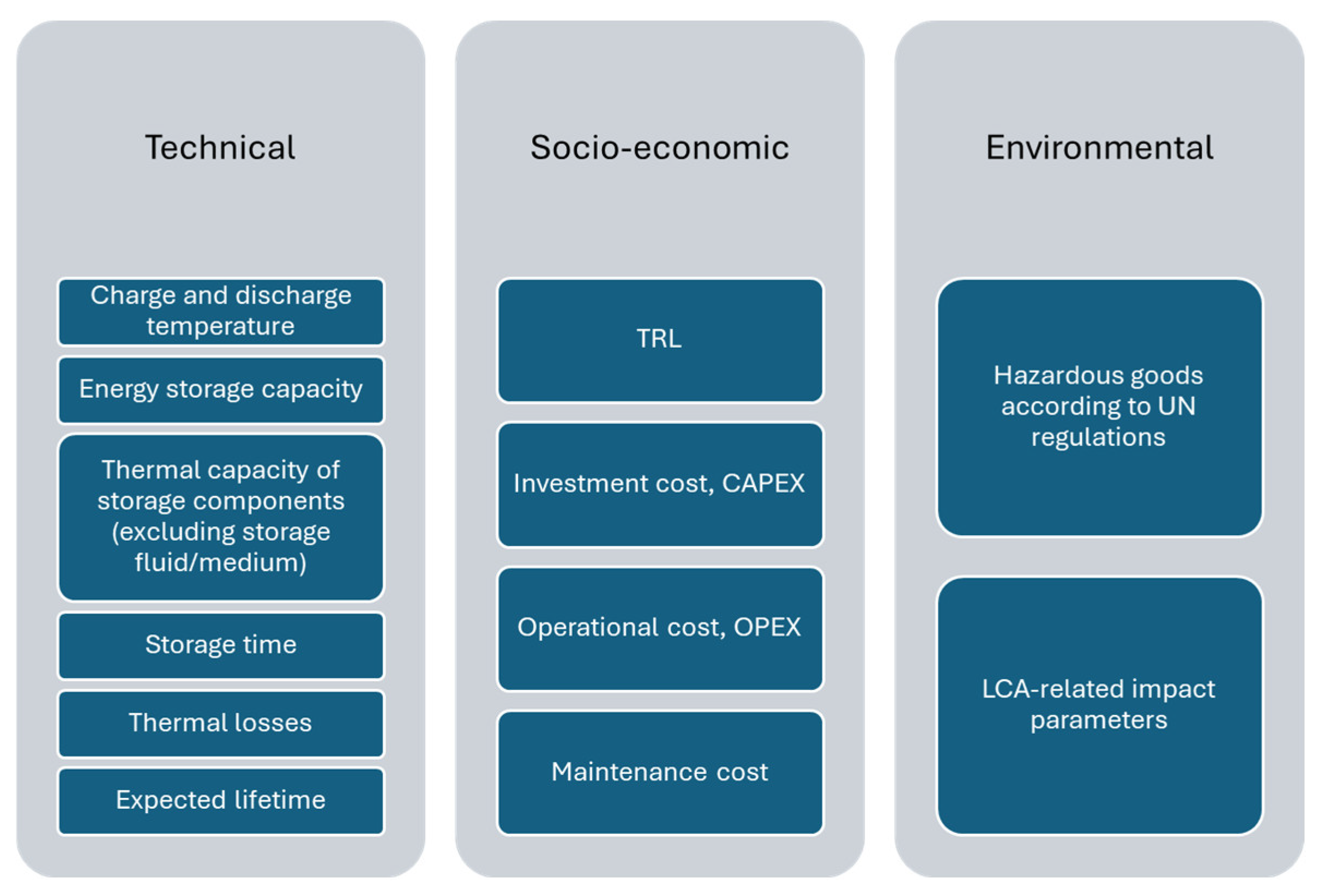
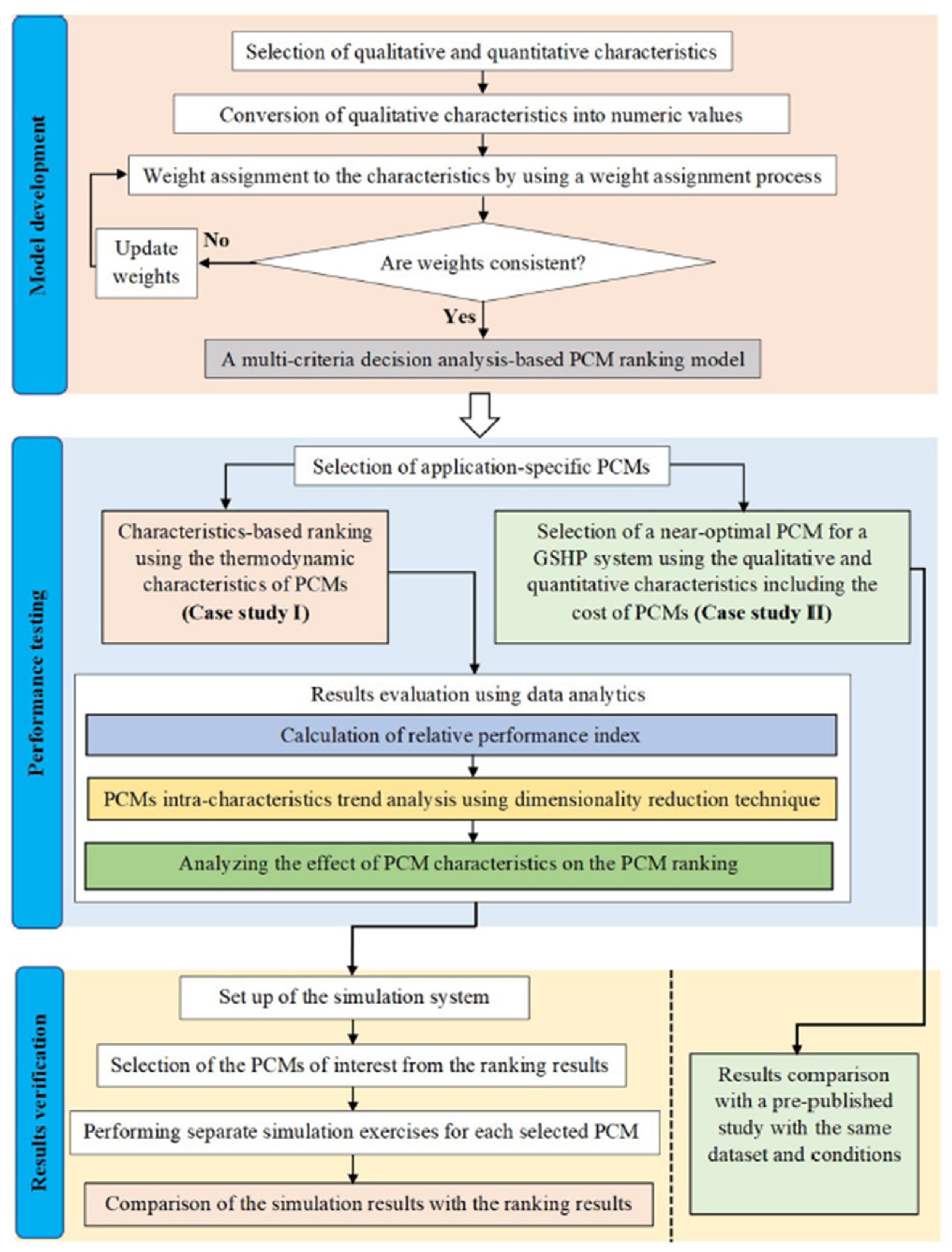
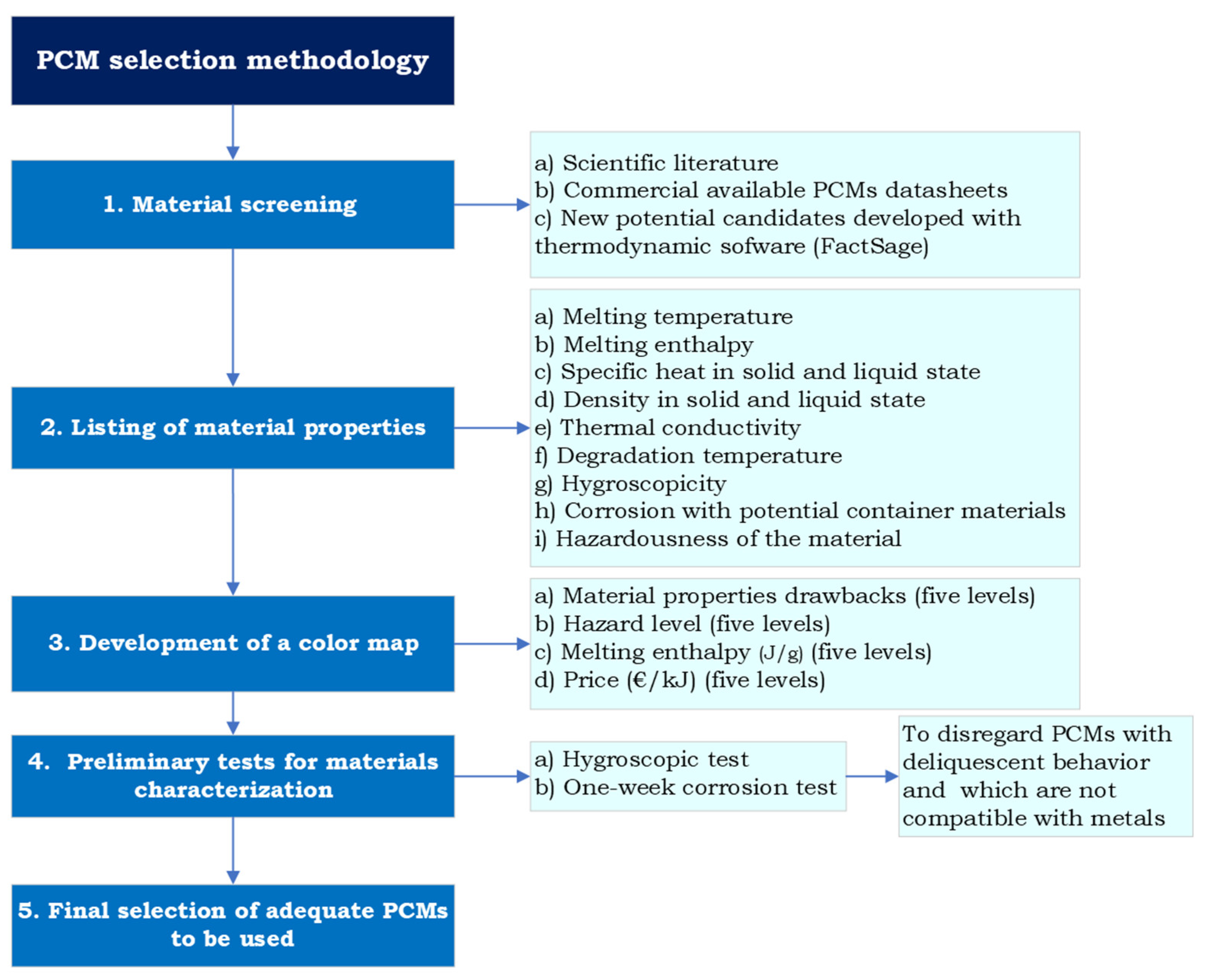
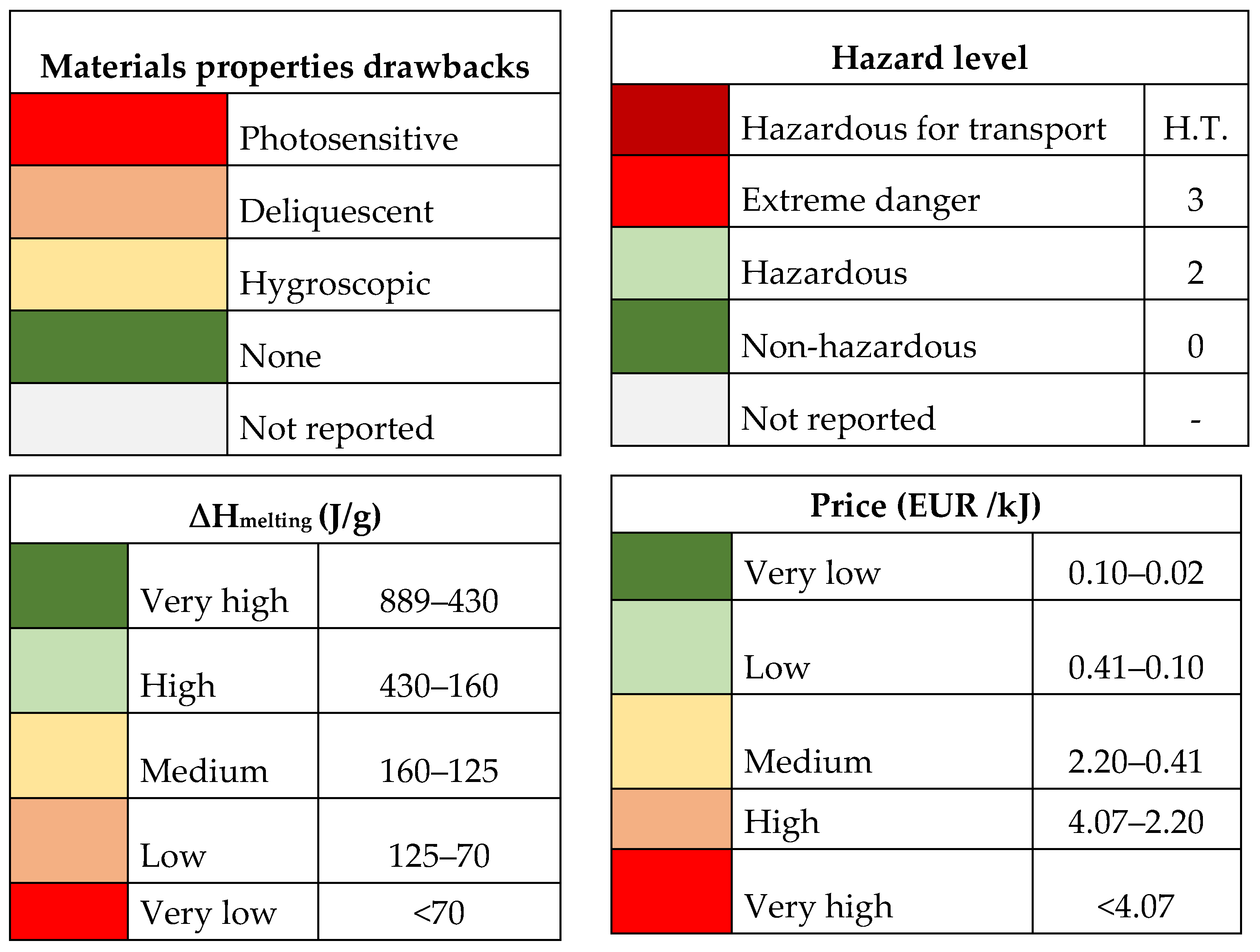
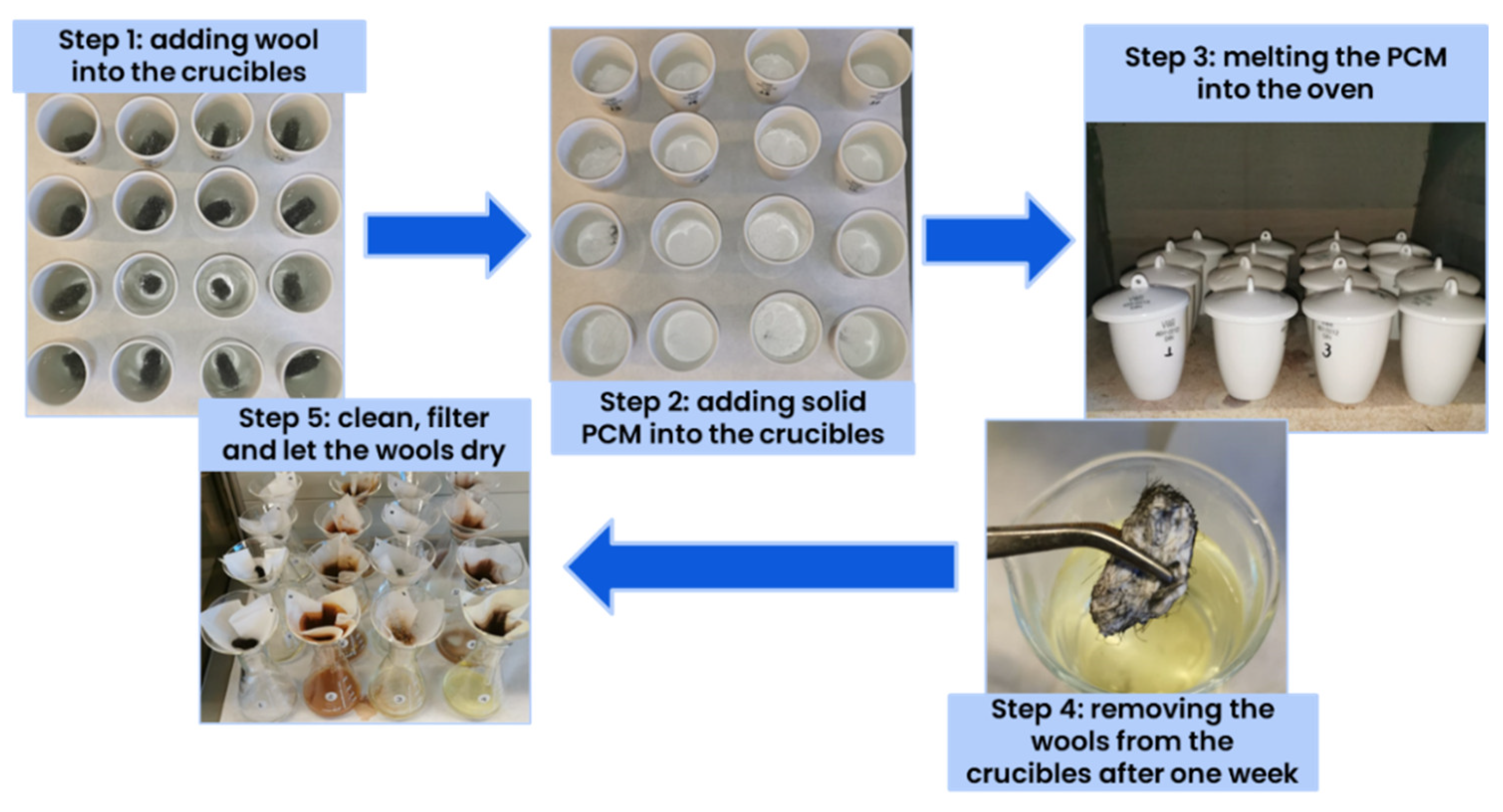
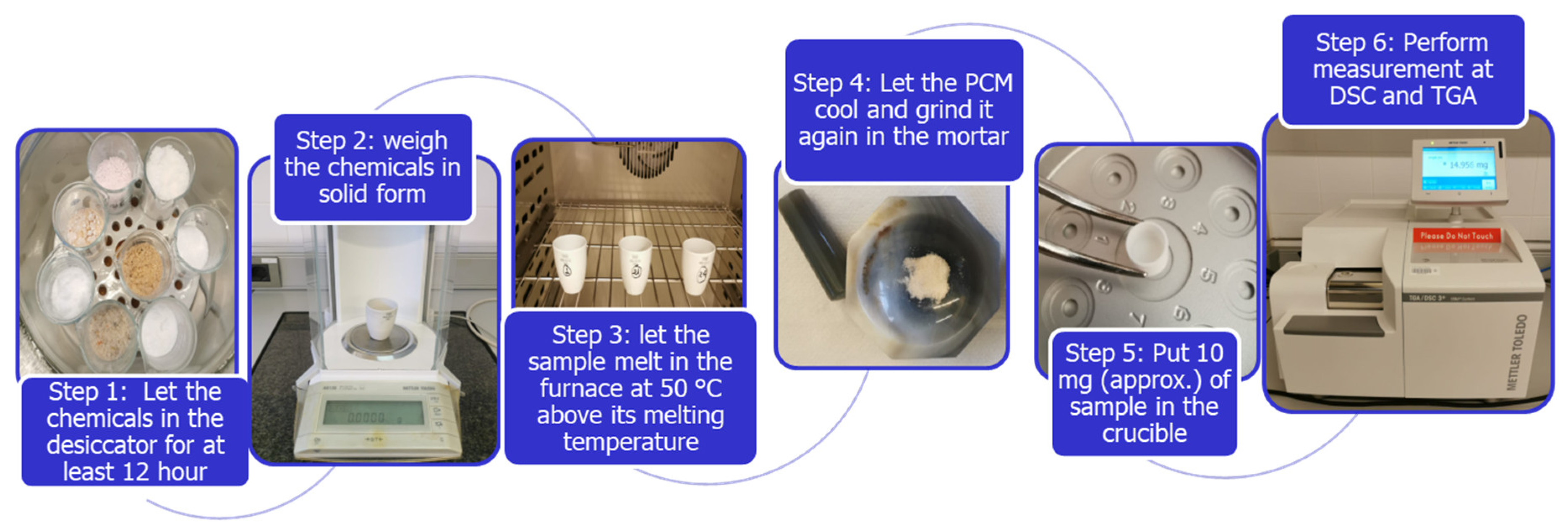


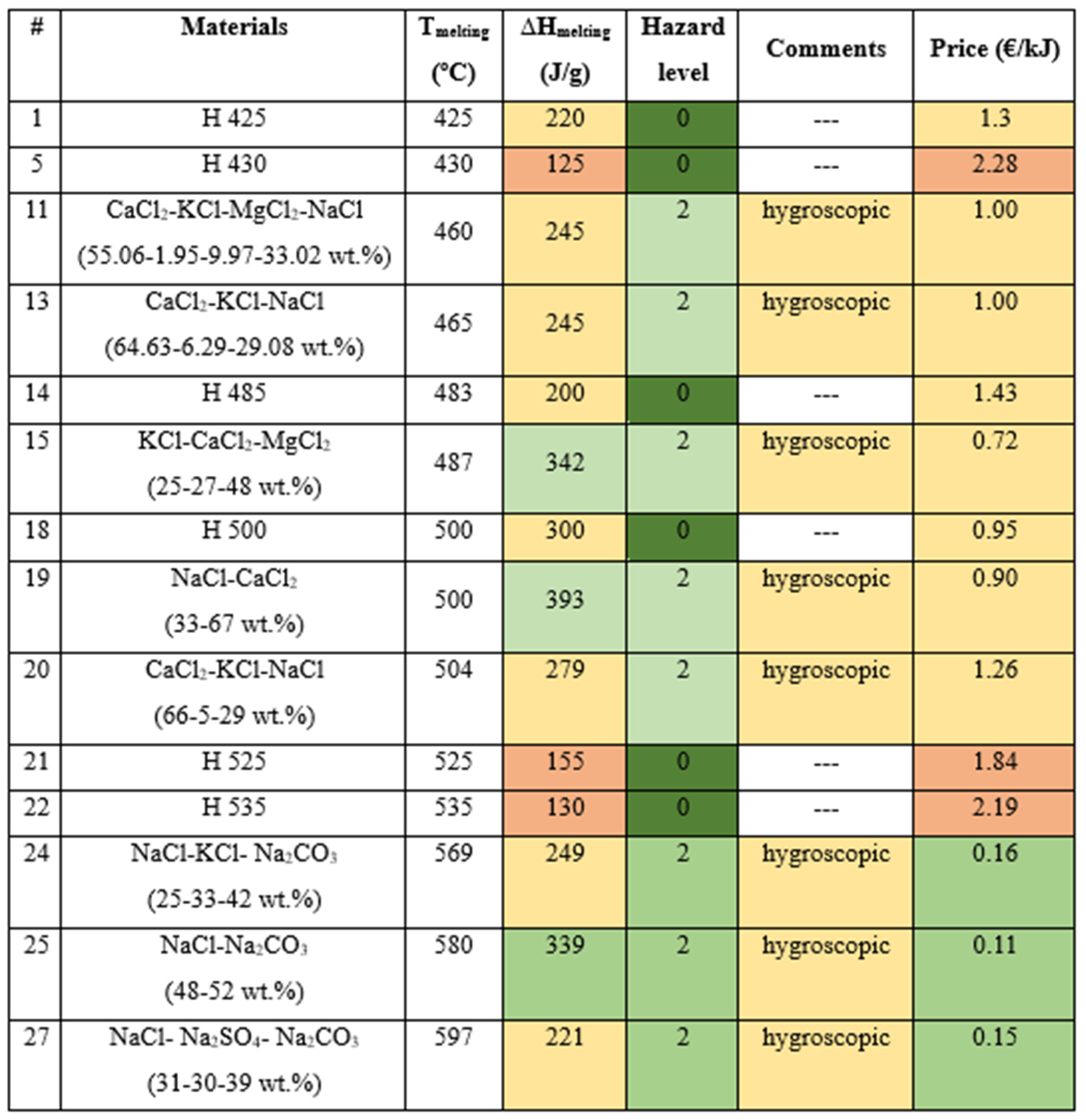
| Temperature Range [°C] | Enthalpy [kJ/kg] | Availability | Price [EUR /kg] | Maximum Working Temperature [°C] | |||||
|---|---|---|---|---|---|---|---|---|---|
| Criteria | Value for Decision | Criteria | Value for Decision | Criteria | Value for Decision | Criteria | Value for Decision | Criteria | Value for Decision |
| T < 2 | 3 | h > 250 | 3 | Yes | 3 | P < 2.5 | 3 | Tmax > 120 | 3 |
| 2 < T < 3 | 2 | 200 < h < 250 | 2 | No | 0 | 2.5 < P < 5 | 2 | Tmax < 120 or n.a. | 0 |
| 3 < T < 4 | 1 | 150 < h < 200 | 1 | --- | --- | 5 < P < 10 | 1 | --- | --- |
| T > 4 or n.a. | 0 | h < 150 or n.a. | 0 | --- | --- | P > 10 or n.a. | 0 | --- | --- |
| # | Materials | Tmelting (°C) | ∆Hmelting (J/g) | Cp solid (J/g·K) | Cp liquid (J/g·K) | ρ solid (kg/m3) | ρ liquid (kg/m3) | k liquid (W/m·K) | Corrosion (mm/Year) | Tdegradation (°C) | NFPA 704 | Ref. |
|---|---|---|---|---|---|---|---|---|---|---|---|---|
| 1 | H 425 | 425 [23] | 220 [23] | 1.54 [23] | - | 2100 [23] | - | 0.57 | - | 1400 [23] | N.H. | [23] |
| 2 | MnCl2-NaCl (64.33-35.67 wt.%) | 426 [24] | 230 [24] | - | - | - | - | - | - | - |  | [24] |
| 3 | LiF-LiOH (20-80 mol%) | 427 [25] | 869 [25] | 0.80 [25] | 1.00 [25] | 1600 [25] | - | - | - | - |  | [25] |
| 4 | LiF-LiOH (21.33-78.67 wt.%) | 431 [24] | 889 [24] | - | - | - | - | - | - | - |  | [24] |
| 5 | H 430 | 430 [23] | 125 [23] | 1.54 [23] | - | 2160 [23] | - | 0.57 [23] | - | 1400 [23] | N.H. | [23] |
| 6 | MgCl2-KCl (39-61 wt.%) | 435 [26] | 351 [26] | 0.80 [26] | 0.96 [26] | 2110 [26] | - | 0.81 [26] | 1.00 [27] | 700 [28] |  | [26,27,28] |
| 7 | MgCl2-RbCl (21.65-78.35 wt.%) | 446 [24] | 135.7 [24] | - | - | -- | - | - | - | - |  | [24] |
| 8 | LiCl-MgCl2 (49.65-50.35 wt.%) | 447 [24] | 401 [24] | - | - | -- | - | - | - | - |  | [24] |
| 9 | LiF-LiBr (8.62-91.38 wt.%) | 450 [24] | 275 [24] | - | - | - | - | - | - | - |  | [24] |
| 10 | NaCl-MgCl2 (48-52 wt.%) | 450 [25] | 430 [25] | 0.92 [25] | 1.00 [25] | 2230 [25] | - | 0.95 [25] | - |  | [25] | |
| 11 | CaCl2-KCl-MgCl2-NaCl (55.06-1.95-9.97-33.02 wt.%) | 460 [25] | 245 [25] | - | - | - | - | - | - | -- |  | [25] |
| 12 | LiOH | 462 [29] | 873 [29] | - | - | 1460 [29] | - | - | - | - |  | [29] |
| 13 | CaCl2-KCl-NaCl (64.63-6.29-29.08 wt.%) | 465 [25] | 245 [25] | - | - | - | - | - | - | - |  | [25] |
| 14 | H 485 | 483 [23] | 200 [23] | 1.55 [23] | - | 2220 [23] | - | 0.57 [23] | - | 800 [23] | N.H. | [23] |
| 15 | KCl-CaCl2-MgCl2 (25-27-48 wt.%) | 487 [25] | 342 [25] | 0.80 [25] | - | 2530 [25] | - | 0.88 [29] | - | - |  | [25,29] |
| 16 | Li2CO3-K2CO3 (47-53 wt.%) | 488 [25] | 342 [25] | 1.03 [25] | 1.34 [25] | 2220 [25] | - | 1.99 [25] | - | 530 [30] |  | [25] |
| 17 | Li2CO3-Na2CO3 (44-56 wt.%) | 496 [25] | 370 [25] | 1.80 [25] | 2.09 [25] | 2320 [25] | - | 2.09 [25] | - | 530 [30] |  | [25] |
| 18 | H 500 | 500 [23] | 300 [23] | 1.55 [23] | - | 2200 [23] | - | 0.57 [23] | - | 800 [23] | N.H. | [23] |
| 19 | NaCl-CaCl2 (33-67 wt.%) | 500 [25] | 393 [25] | 0.84 [25] | 1.00 [29] | 2160 [25] | - | 1.20 [25] | - | - |  | [25,29] |
| 20 | CaCl2-KCl-NaCl (66-5-29 wt.%) | 504 [29] | 279 [29] | 1.17 [29] | 1.00 [29] | 2150 [29] | - | 1.00 [29] | - | - |  | [29] |
| 21 | H 525 | 525 [23] | 155 [23] | 1.56 [23] | - | 2350 [23] | - | 0.57 [23] | - | 1000 [23] | N.H. | [23] |
| 22 | H 535 | 535 [23] | 130 [23] | 1.57 [23] | - | 2320 [23] | - | 0.56 [23] | - | 1000 [23] | N.H. | [23] |
| 23 | Ca(NO3)2 | 560 [29] | 145 [29] | - | - | 2113 [29] | - | - | - | 500 [31] |  | [29] |
| 24 | NaCl-KCl-Na2CO3 (25-33-42 wt.%) | 569 [7] | 249 [7] | 1.34 [7] | 1.41 [7] | 1700 [7] | 2000 [7] | 0.50 [7] | - |  | [7] | |
| 25 | NaCl-Na2CO3 (48-52 wt.%) | 580 [7] | 339 [7] | 1.3 [7] | - | 2000 [7] | - | 0.60 [7] | - |  | [7] | |
| 26 | Li2CO3-Na2CO3-K2CO3 (22-16-62 wt.%) | 580 [25] | 288 [25] | 1.80 [25] | 2.90 [25] | 2340 [25] | - | 1.95 [25] | - | 827 [30] |  | [25] |
| 27 | NaCl-Na2SO4-Na2CO3 (31-30-39 wt.%) | 597 [7] | 221 [7] | 1.20 [7] | 1.30 [7] | 2000 [7] | - | 0.50 [7] | - |  | [7] |
| # | Materials | Tmelting (°C) | ∆Hmelting (J/g) | Hazard Level | Comments | Price (EUR /kJ) |
|---|---|---|---|---|---|---|
| 1 | H 425 | 425 | 220 | 0 | -- | 1.30 |
| 2 | MnCl2-NaCl (64.33-35.67 wt.%) | 426 | 230 | 3 | photosensitive | 0.24 |
| 3 | LiF-LiOH (20-80 mol%) | 427 | 869 | 3 | hygroscopic | 352.12 |
| 4 | LiF-LiOH (21.33-78.67 wt.%) | 431 | 889 | 3 | hygroscopic | 0.35 |
| 5 | H 430 | 430 | 125 | 0 | -- | 2.28 |
| 6 | MgCl2-KCl (39-61 wt.%) | 435 | 351 | 3 | hygroscopic | 0.28 |
| 7 | MgCl2-RbCl (21.65-78.35 wt.%) | 446 | 136 | 3 | hygroscopic | -- |
| 8 | LiCl-MgCl2 (49.65-50.35 wt.%) | 447 | 401 | 3 | hygroscopic | -- |
| 9 | LiF-LiBr (8.62-91.38 wt.%) | 450 | 275 | 3 | deliquescent | -- |
| 10 | NaCl-MgCl2 (48-52 wt.%) | 450 | 430 | 3 | hygroscopic | 0.25 |
| 11 | CaCl2-KCl-MgCl2-NaCl (55.06-1.95-9.97-33.02 wt.%) | 460 | 245 | 2 | hygroscopic | 1.00 |
| 12 | LiOH | 462 | 873 | 3 | deliquescent | 0.38 |
| 13 | CaCl2-KCl-NaCl (64.63-6.29-29.08 wt.%) | 465 | 245 | 2 | hygroscopic | 1.00 |
| 14 | H 485 | 483 | 200 | 0 | -- | 1.43 |
| 15 | KCl-CaCl2-MgCl2 (25-27-48 wt.%) | 487 | 342 | 2 | hygroscopic | 0.72 |
| 16 | Li2CO3-K2CO3 (47-53 wt.%) | 488 | 342 | 3 | hygroscopic | 0.99 |
| 17 | Li2CO3-Na2CO3 (44-56 wt.%) | 496 | 370 | 3 | hygroscopic | 0.21 |
| 18 | H 500 | 500 | 300 | 0 | -- | 0.95 |
| 19 | NaCl-CaCl2 (33-67 wt.%) | 500 | 393 | 2 | hygroscopic | 0.90 |
| 20 | CaCl2-KCl-NaCl (66-5-29 wt.%) | 504 | 279 | 2 | hygroscopic | 1.26 |
| 21 | H 525 | 525 | 155 | 0 | -- | 1.84 |
| 22 | H 535 | 535 | 130 | 0 | -- | 2.19 |
| 23 | Ca(NO3)2 | 560 | 145 | 3 | deliquescent | 0.12 |
| 24 | NaCl-KCl-Na2CO3 (25-33-42 wt.%) | 569 | 249 | 2 | hygroscopic | 0.16 |
| 25 | NaCl-Na2CO3 (48-52 wt.%) | 580 | 339 | 2 | hygroscopic | 0.11 |
| 26 | Li2CO3-Na2CO3-K2CO3 (22-16-62 wt.%) | 580 | 288 | 3 | hygroscopic | 0.22 |
| 27 | NaCl-Na2SO4-Na2CO3 (31-30-39 wt.%) | 597 | 221 | 2 | hygroscopic | 0.15 |
| PCM | Stainless Steel 314 | Stainless Steel 434 | Alloy 20 | |||
|---|---|---|---|---|---|---|
| Before tests |  |  |  | 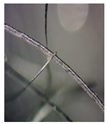 | 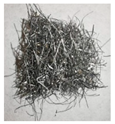 |  |
| NaOH | 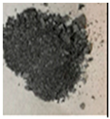 | n.a. | 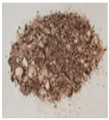 | n.a. | 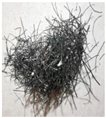 | 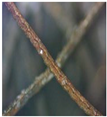 |
| Comments (Test temperature) | Failed (T = 450 °C) | Failed (T = 450 °C) | Passed (T = 340 °C) | |||
Disclaimer/Publisher’s Note: The statements, opinions and data contained in all publications are solely those of the individual author(s) and contributor(s) and not of MDPI and/or the editor(s). MDPI and/or the editor(s) disclaim responsibility for any injury to people or property resulting from any ideas, methods, instructions or products referred to in the content. |
© 2024 by the authors. Licensee MDPI, Basel, Switzerland. This article is an open access article distributed under the terms and conditions of the Creative Commons Attribution (CC BY) license (https://creativecommons.org/licenses/by/4.0/).
Share and Cite
Cabeza, L.F.; Martínez, F.R.; Borri, E.; Ushak, S.; Prieto, C. Thermal Energy Storage Using Phase Change Materials in High-Temperature Industrial Applications: Multi-Criteria Selection of the Adequate Material. Materials 2024, 17, 1878. https://doi.org/10.3390/ma17081878
Cabeza LF, Martínez FR, Borri E, Ushak S, Prieto C. Thermal Energy Storage Using Phase Change Materials in High-Temperature Industrial Applications: Multi-Criteria Selection of the Adequate Material. Materials. 2024; 17(8):1878. https://doi.org/10.3390/ma17081878
Chicago/Turabian StyleCabeza, Luisa F., Franklin R. Martínez, Emiliano Borri, Svetlana Ushak, and Cristina Prieto. 2024. "Thermal Energy Storage Using Phase Change Materials in High-Temperature Industrial Applications: Multi-Criteria Selection of the Adequate Material" Materials 17, no. 8: 1878. https://doi.org/10.3390/ma17081878







